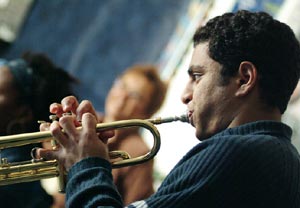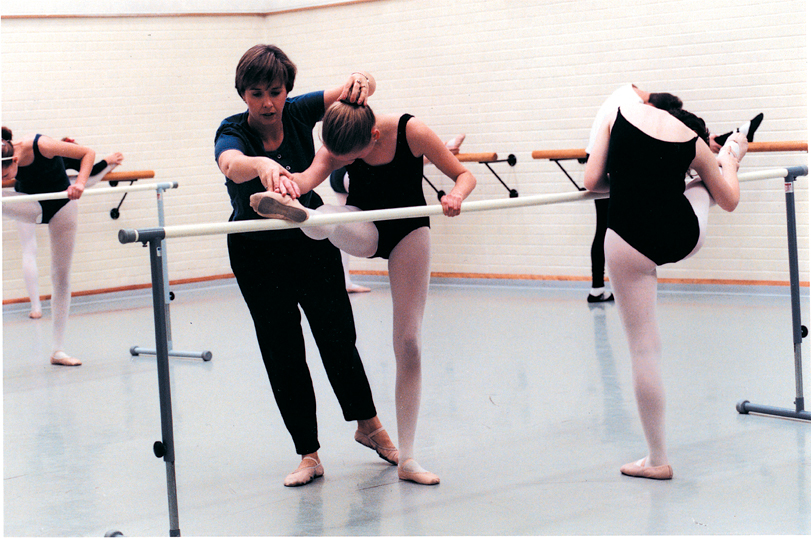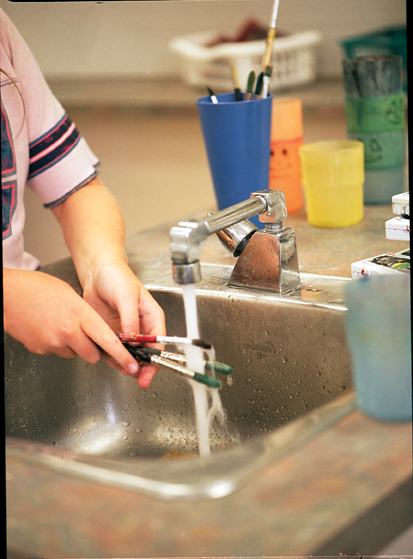|
by Joyce
Mason
The idea that art
contains messages, reveals meaning and elicits understanding is perhaps
the first reason that teachers consider it integral to education. Art
teaches us things.
But the highest recommendation for art in schools - that it can be a source
of delight - is the very thing that makes it seem a frivolous extra to
some, and in today's cash-strapped education environment, arts programs
are often the first cut.
There are problems with the delivery of arts in Ontario schools. But one
of the largest stumbling blocks in assessing and addressing the situation
is a lack of hard statistical data.
"This is one of the real tragedies of the situation: we just don't
have the statistics we need," says George Bishop, president of the
Coalition for Music Education in Canada. To gather reliable current data
on what is happening across the province would require a lot of money
and co-operation and Bishop suggests some seem wary of giving information.
"The Ministry of Education should have some statistics, but if it
does, it isn't giving them to us," complains Bishop. "At the
school level, when principals are cutting a school music program in order
to maintain a library, they aren't eager to fill in voluntary surveys
that might measure the delivery of arts in the schools.
"One thing I do know is that, when we looked at 32 major school boards
in southern Ontario in 1992, every board had a music co-ordinator. Today
there is one left in Toronto," says Bishop, then adds, "The
problem is that now - with amalgamation - that person is re-sponsible
for six former boards!"
Demand remains, resources dwindle
 Various
structural changes add to the difficulty in assessing change. "Even
if you had current data and some from 10 years ago, things are not directly
comparable," says Alan King, who has just completed year two of a
study for the Ministry of Education on the impact of the double cohort
(due for release in September). Various
structural changes add to the difficulty in assessing change. "Even
if you had current data and some from 10 years ago, things are not directly
comparable," says Alan King, who has just completed year two of a
study for the Ministry of Education on the impact of the double cohort
(due for release in September).
"With the compression of five years into four and the increase in
required credits from 16 to 18, it was feared that there would be a negative
impact on the arts." But the data so far shows that there has not
been a reduction in the proportion of arts courses taken by students at
the high school level. The numbers for students in Grade 11 who are taking
music (16 per cent), Visual Arts (20 per cent) and Dramatic Arts (12 per
cent) remain about the same as in the previous system. Nonetheless, there
has been an effect.
"There is a reduction in the number of students due to the loss of
that extra year," King notes. "And since music and visual art
tend to be smaller departments to begin with, this loss of overall enrolment
makes it harder to sustain programs in particular schools." The programs
may still run, but they must be combined. Some schools combine their Grade
11 and 12 classes, smaller schools may partner with another school.
Susan Davies, an arts co-ordinator with the Hastings and Prince Edward
board, agrees. "One of the bigger problems for us has been the reduction
of one year from the secondary program. It's making it difficult to maintain
programs like music and band that rely on students who take music every
year."
Since resources are allocated on the basis of course selections by students,
the consequences for continued arts programs are clear. In Simcoe County,
some secondary schools facing these challenges have partnered with their
feeder schools to introduce instrumental music to students and build a
foundation for more sustained high school participation.
In elementary schools the problems are different. Secondary school arts
advocates may complain that the increase in the number of required courses
and reduction in years leaves art options in the shadows. But in elementary
schools, curriculum changes have created another dilemma.
The 1998 arts curriculum provides a strong validation for the arts. But
it has been hard for teachers to hold to its promises. "The biggest
problem is that the resources are reduced," says King. "Especially
in elementary schools."
Despite the rigour and demands of arts curriculum and the implicit respect
these give to the arts, some veteran teachers continue to wonder whether
the sequential learning outlined is realistic in elementary school and
most worry about how they can deliver it.
"While the curriculum seems to offer a certain seriousness and respect
to the arts, it sometimes feels a little like bean-counting," says
Wendy Hughes, a veteran elementary teacher currently teaching Grade 5
in Toronto. "Not everything has to happen in a certain order.
"In math, it's true, you must know how to multiply before you can
divide,' Hughes says. "But for kids to make a painting, the sequence
in which you learn about horizon lines and the colour wheel just isn't
that important. And it isn't always developmentally appropriate. You need
to keep giving kids opportunities - every year. The first thing is really
to get comfortable with the materials!"
Visual art in an elementary classroom can be messy, expensive and time-consuming.
"I have $10 per kid for supplies - that's arts, science, notebooks,
the works,!" says Kevin Hunt, who teaches Grade 7 during the school
year and acts as teacher director for the arts during the summer in Richmond
Hill.
Combined budget restrictions and competing demands mean that teachers
must be creative. And Hunt also worries that, with only one period out
of 40 allocated to visual art, some teachers double up, having a cover
illustration in coloured pencil on the next research project fulfill the
art requirement.
Hughes points out that "for teachers who are less interested in art
or less confident, the curriculum can allow them to turn art into another
academic subject. I see less and less real art activity going on - less
picture-making."
Help at hand
 For
experienced and novice teachers alike programs that connect community
arts organizations with the schools have provided in-class professional
development for many. In Barrie an official partnership with the McLaren
Art Centre puts visual artists in classrooms. "The teachers learn
along with the students," explains Jennifer Copeland of the Simcoe
County board. For
experienced and novice teachers alike programs that connect community
arts organizations with the schools have provided in-class professional
development for many. In Barrie an official partnership with the McLaren
Art Centre puts visual artists in classrooms. "The teachers learn
along with the students," explains Jennifer Copeland of the Simcoe
County board.
Recent increases in funding to the Ontario Arts Council (OAC) should make
such opportunities more accessible. The OAC's Artists in the Schools program,
which covers fees and travel expenses for artists who work with teachers
in the classroom, will have an additional $621,000 this year - an increase
of more than 50 per cent.
Program co-ordinator Jay Pitter says they want to broaden the reach of
the program and permit longer residencies. In general, artists approach
schools to offer their services, but schools can also approach OAC for
help in hooking up with an artist (jpitter@oac.on.ca).
"We get great feedback on the tremendously positive impact that these
visits have on students."
Steven Campbell, Director of Community Partnerships at OAC, says that
arts education is a key issue in their strategic plan. So additional funds
will also go to art education programs, which funds groups that perform
in schools, and the core funding of organizations that offer educational
programs.
Community resources and partnerships are recurring themes when educators
talk about attempts to maintain their visual arts, drama, dance and music
programs.
"Our arts programs have continued despite the lack of personnel and
financial resources," says Lorne Keon, director of the Renfrew County
Catholic District School Board. "Thanks to the expert skill of our
staff and with the help of our retired teachers, the vocal music programs
have continued to be a success."
"As a small school, we have to be innovative," says Cheryl St-Elier,
the principal at Our Lady of Grace Elementary School in Renfrew. With
35 students in two classrooms, the school's two teachers merged drama
and language arts for their junior grade students.
In preparation for a presentation of Carnival of the Animals, a play by
Saint-Saens, they explored scriptwriting, peer editing and brainstorming.
The children each wrote a story, using the elements and themes in the
play. Both students and teachers benefited as teachers taught themselves
new methods.
"Wherever we go we'll bring this with us," observed St-Elier.
"It becomes another pedagogical model of program delivery and planning."
For Our Lady of Grace, the play paid off literally as well as educationally.
Sister schools in the region bused in students to watch and the play even
went on a small tour. So, while the start up costs for producing the play
approached $500, the revenue generated was approximately $2,000.
 On the other
hand On the other
hand
But arts programming does not always turn a profit and overall funding
cuts do leave teachers scrambling to make up shortfalls.
People for Education reports that 58 per cent of elementary schools had
a full-time music teacher in 1997/98. In 2002/03 the number dropped to
41 per cent. For the visual arts, already less prominent, the numbers
dropped from 20 per cent in 1998/99 to 19 per cent in 2002/03.
Different schools and boards make different choices. But, Annie Kidder
of People for Education notes that the figures reflect the elimination
of instrumental music in most elementary schools. Meanwhile, thanks to
the combination of curriculum requirements and the low cost of the instrument,
vocal music has nonetheless survived.
And of course, in art instruction, the audience experience must not be
forgotten. In teaching children to read, it is recognized that seeing
those around them as readers is essential. It is no great stretch to extrapolate
that the experience of art as something done by people in your world is
similarly significant. Those who see others making art, who see lives
organized in ways that leave time and space for art-making will be more
likely to want to make art - or to value those who do make art - as adults.
"The inspirational impact of top-level performers in the schools
is incalculable," says Hughes. "When you see the rapt look on
the face of a kid who may never have had the opportunity to see a live
performance before, it is wonderful." In fact, the inspiration factor
is important for teacher and student alike.
Questions abound when it comes to why and how to teach art. There are
no simple answers. The world of teaching, like art itself, has unending
layers of intention, meaning and possibilities. So in upcoming editions
of Professionally Speaking, we will offer readers some insights
and experiences of teachers delivering the arts in their classrooms.
|


